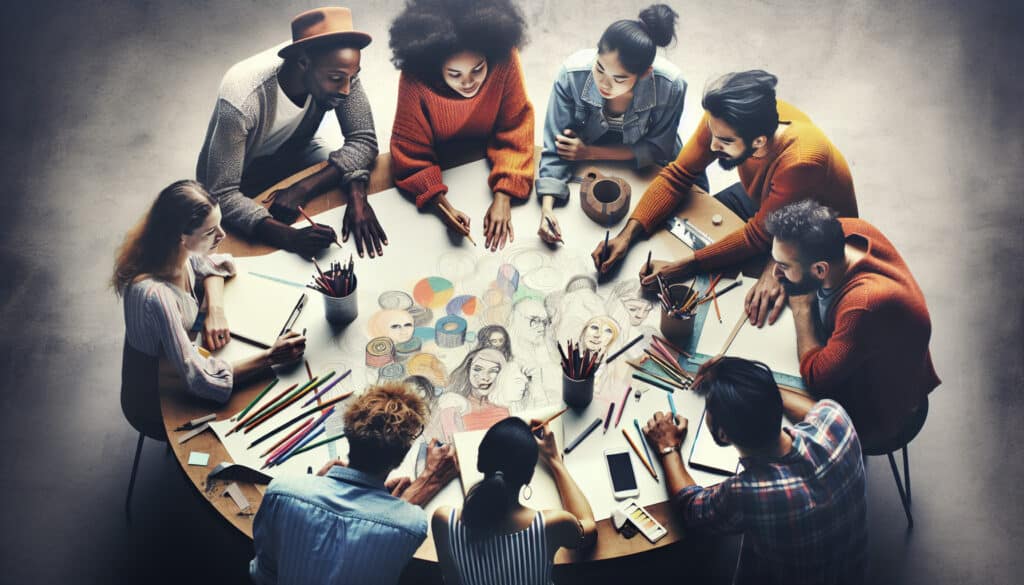A design activity where multiple participants create sketches together to explore and communicate ideas visually.
- Méthodologies : Clients et marketing, Conception de Produits
Collaborative Sketching

Collaborative Sketching
- Remue-méninges, Pensée conceptuelle, Conception centrée sur l'humain, Conception d'interaction, Prototypage, Expérience utilisateur (UX), Interface utilisateur (UI), Conception visuelle
Objectif :
Comment il est utilisé :
- In a workshop setting, team members or users collectively draw concepts for a interface utilisateur, workflow, or product, building on each other's visual ideas in real-time.
Avantages
- Encourages participation from everyone, regardless of drawing skill; generates a wide range of ideas quickly; and creates a shared visual understanding of concepts.
Inconvénients
- Can be chaotic without good facilitation, may be intimidating for non-visual thinkers, and the focus is on ideation, not detailed design.
Catégories :
- Idéation, Conception de Produits
Idéal pour :
- Rapidly generating and exploring design ideas in a group setting to create a shared vision.
Collaborative Sketching finds significant applications across various industries including technology, consumer products, healthcare, and education, functioning effectively during the early phases of product development and design thinking workshops. In environments where rapid ideation is necessary, such as during design sprints or brainstorming sessions, team members, including designers, engineers, project managers, and even end users, come together to visualize ideas, blending their diverse expertise to create solutions that address real user needs. This methodology is particularly advantageous when developing user interfaces and workflows, as it allows participants to iterate designs based on immediate feedback, refining concepts in real time. By engaging everyone in the sketching process, organizations can break down communication barriers, harnessing the collective creativity and knowledge of the group while ensuring that the visual outcomes are aligned with user expectations. This approach is not limited to formal workshops; it can also be implemented in informal settings or remote collaboration tools, where digital sketching applications facilitate participation across different locations. As a result, teams can explore and fine-tune ideas quickly, leading to innovative solutions that benefit from the diverse perspectives and ideas generated during the sketching sessions.
Principales étapes de cette méthodologie
- Set a clear design objective for the session.
- Introduce drawing tools and materials for all participants.
- Initiate the sketching process with one person drawing a design idea.
- Encourage others to build upon the initial drawing with additional elements or modifications.
- Rotate drawing responsibilities among participants to involve everyone.
- Facilitate discussions around sketches to clarify intentions and ideas.
- Utilize a timer for rapid sketching sessions to maintain momentum.
- Record and document the evolving sketches for future reference.
- End the session with a review of the created sketches to consolidate ideas.
Conseils de pro
- Utilize sticky notes alongside sketching to capture and prioritize ideas without interrupting the flow of drawing.
- Assign a facilitator to ensure balanced participation and to synthesize the group's output into coherent themes.
- Incorporate time constraints for each sketching round to encourage quick ideation and prevent overthinking.
Lire et comparer plusieurs méthodologies, nous recommandons le
> Référentiel méthodologique étendu <
ainsi que plus de 400 autres méthodologies.
Vos commentaires sur cette méthodologie ou des informations supplémentaires sont les bienvenus sur le site web de la Commission européenne. section des commentaires ci-dessous ↓ , ainsi que toute idée ou lien en rapport avec l'ingénierie.
Contexte historique
1949
1950
1950
1960
1960
1960
1960
1940
1950
1950
1958
1960
1960
1960
1960
(si la date est inconnue ou n'est pas pertinente, par exemple "mécanique des fluides", une estimation arrondie de son émergence notable est fournie)















Articles Similaires
Questionnaires sur les troubles musculo-squelettiques
Tests à plusieurs variables (MVT)
Analyse de régression multiple
Systèmes de capture de mouvement
Méthode MoSCoW
Test de la médiane de Mood